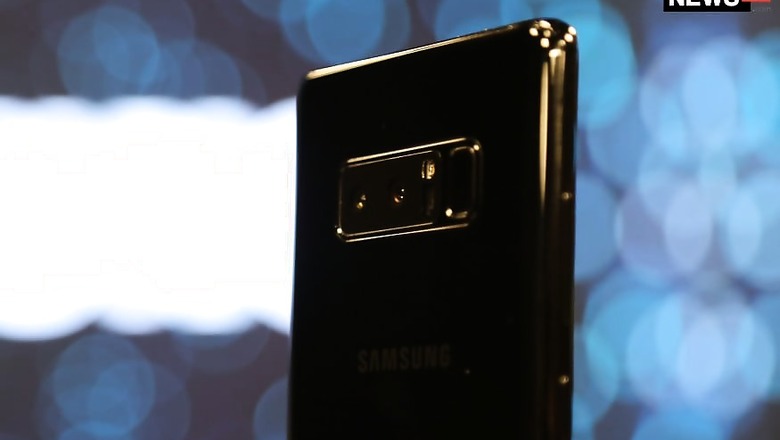
views
As the year 2017 comes to a close, a look back at the smartphone industry’s journey within the year reveals a drastic trickling down of technology from high-end smartphones to more budget-friendly offerings. The most talked about amongst these, are the near bezel-less display and the dual-lens camera setup. First offered only on flagships, the competitive market took almost no time to adopt features like an 18:9 aspect ratio display and several others and make it available at affordable prices globally. Despite the cloning of these features, various flagships have managed to stand apart with their unique as well as revolutionary offerings.
Here are the top flagship smartphones launched in 2017 and how they have more or less revolutionised the smartphone game altogether.
1. Samsung Galaxy Note 8
Samsung had all eyes upon it at the time of the Galaxy Note 8 launch as the company battled to put an end to the scepticism faced by it after the Galaxy Note 7 fiasco. And the South Korean giant did amazingly well indeed. Samsung’s flagship for 2017 had everything going to easily rank it as the best flagship smartphone of the year. A large, near the bezel-less display, top of the line specifications and a dual camera setup which was missing from its earlier flagship offerings, the Galaxy S8 and the S8 Plus. In addition, Samsung completely redesigned its S-Pen functionality with the Galaxy Note 8, now making it capable of creating live messages, animations, GIFs, translations, texts inside images, notes on the lock screen and what not. As a first, the Galaxy Note 8 also came with dual OIS on its dual-lens camera setup at the back.
2. Apple iPhone X
Apple celebrated the ten year anniversary of its iPhone line-up with a bang. Along with the regular series additions - iPhone 8 and iPhone 8 Plus, Apple introduced a special Tenth-Anniversary Edition iPhone as the iPhone X. There is no doubt that the Cupertino tech company went all out for this, introducing a bezel-less display for the first time along with an all-new A11 bionic chip for powering it and as a highlight – a Face ID technology to do away with fingerprint sensors and other security features. In addition, the iPhone X also boasted of wireless charging support, an all glass cover at both front and the back as well as augmented reality support.
To add a little bit of fun to the class, Apple also unveiled Animoji - animated emoticons wherein the smartphone’s TrueDepth camera captures and analyses over 50 different facial muscle movements, then animates those expressions in a dozen different Animojis, including that of a panda, unicorn and robot.
3. Samsung Galaxy S8/ S8 Plus
Samsung has been known to introduce revolutionary designs with its ‘Galaxy’ flagships. In 2016, it was the ‘Edge’ display with the Galaxy S7 Edge. This year, Samsung built upon that design and unveiled the much appealing, and on many levels, a never-seen-before design with the Galaxy S8 and the S8 Plus. The smartphones sported an edge-to-edge display, which Samsung termed as the ‘Infinity’ display. An Infinity display at the front and a glass cover at the back certainly made the smartphones stand apart from anything available in the market at the time. And it is not only the looks, as always, the Samsung Galaxy flagships came with the highest firepower available back then, with a Snapdragon 835 processor, latest Android version and more. The only one feature that Samsung skipped out on in its flagships at the time was a dual camera setup. Rest assured, the Samsung Galaxy S8 and S8 Plus still carry that charm with which they were first unveiled to the world.
4. OnePlus 5T
OnePlus is known for making ‘Flagship killer’ devices and this holds true to much extent. Being a comparatively new company, the Chinese OEM has not been able to provide as many services to its users as the prevailing players, like the Samsung Pay or iCloud storage. But one thing that the company has completely managed to pull off, and rather marvellously so, is bringing the same technology in its devices as the other flagships and at almost half the price across the globe. A very recent example of this is the ‘Face Unlock’ feature on the OnePlus 5T, introduced right after Apple iPhone X’s Face ID. What’s more applaud-able is that we found the one on the OnePlus 5T to be faster than the latter. So much so for the gigantic price difference between the two.
Agreed, the device seems to miss out on some things hidden to the eye, like the recently surfaced reports of OnePlus smartphones missing the certification to play HD videos on some video streaming platforms. But looking at the overall picture, there is no way that the smartphone experience on the OnePlus devices can be considered substandard, thanks to their top of the line specifications. And of course, we can’t really miss mentioning the Dash Charging here.
5. Honor 8 Pro
Huawei’s sub-brand has been known for making affordable flagships, just like OnePlus, and with commendable camera capabilities. Honor was also one of the very first companies to introduce a dual camera setup in its smartphone line-up. Honor 8 Pro comes with all the known Honor positives, backed by Honor’s own firepower, in the form of an octa-core Kirin processor, EMUI 5.0, a massive 4000 mAh battery and a dual camera setup at the back. Honor successfully managed to give a tough fight to any smartphone in its price range with the Honor 8 Pro at the time of its launch.
Which one is your favourite from this list? Or would you like to add a new name to this? Let us know in the comment section below.




















Comments
0 comment